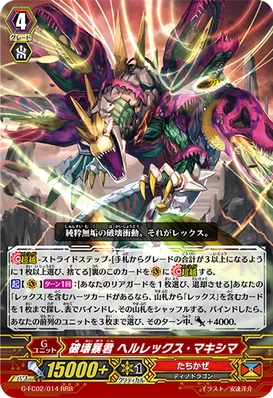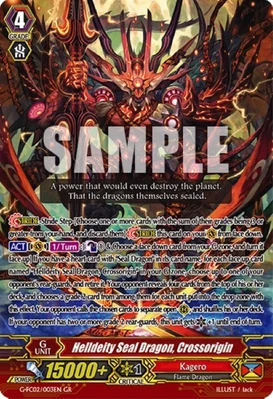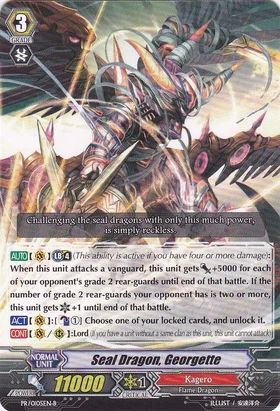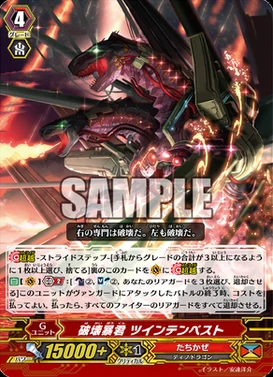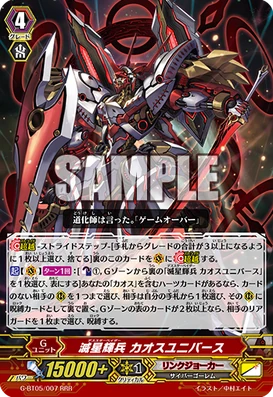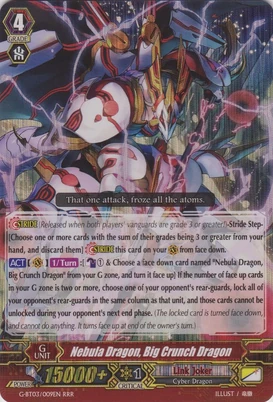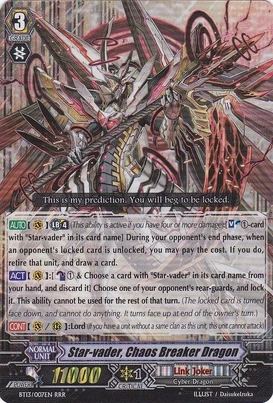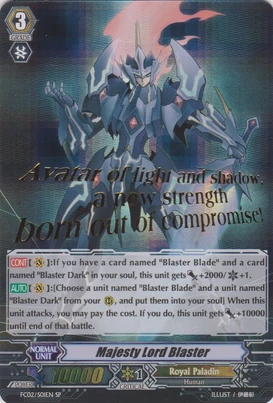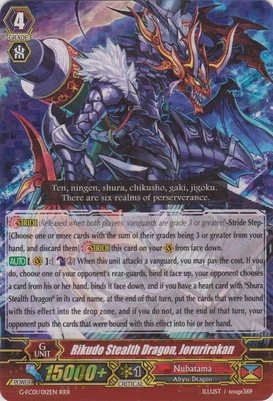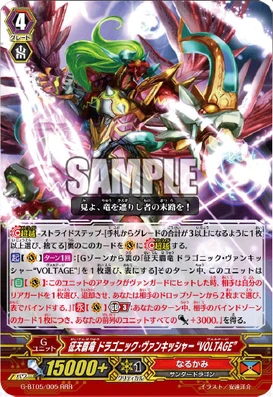The fact that there's too many clans in the game is nothing new. As of now, there are 25 clans in the game, 26 if you count Cray Elementals (which I won't). On top of all the original clans introduced in the sets coinciding with season 1 of the anime (Sets 1-5), we received 4 new clans in Season 2 (Gold Paladin, Narukami, Angel Feather, and Aqua Force), 2 new clans in Season 3 (Genesis and Link Joker), and 2 new clans in Season 5 (Touken Ranbu and Gear Chronicle). So the sake of doing so (and to make this article longer), I'll provide a list of all the current clans:
- Royal Paladin
- Gold Paladin
- Shadow Paladin
- Angel Feather
- Genesis
- Oracle Think Tank
- Kagero
- Narukami
- Murakumo
- Nubatama
- Tachikaze
- Dark Irregulars
- Pale Moon
- Spike Brothers
- Gear Chronicle
- Granblue
- Bermuda Triangle
- Aqua Force
- Neo Nectar
- Great Nature
- Megacolony
- Nova Grappler
- Dimension Police
- Link Joker
As of now, the game has received a total of 22 Booster Sets, 21 Trial Decks, and 17 Extra/Clan Booster Sets. With 5 Seasons of support, that boils down to about 4 Booster Sets, 5 Trial Decks, and 3 Extra Boosters per season. That means each season, there are 12 outlets to give support to the 25 clans in the game. Since Extra Boosters (Which have basically been replaced by Clan Boosters) generally only support 1 clan, its up to the Trial Decks and Main Boosters to support 22 clans, divided amongst 9 possible forms of distribution. It doesn't help that Trial Decks are rarely stand alone, and requiring actual set space in order to flesh out the support for their clans. I do this on a season-by-season basis because, if a clan doesn't receive support each season, it essentially becomes unplayable until the next cycle, given the game's format of "New Mechanic each season".
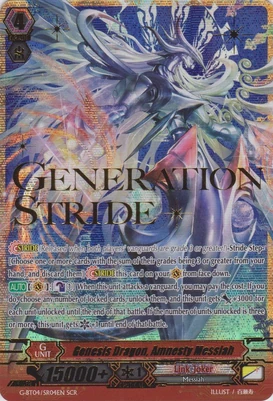
Now that we've seen the amount of support each season isn't enough to sustain a game full of 25 clans, each vying for space in those sets, how should Bushi go about fixing this? One solution would be to simply release more sets each season, but all that would really do is increase the amount of time between the periods where any singular clan would receive support. Plus, if the support a clan/deck gets for that set is fairly lackluster (as Bushi has a tendency to do to anything not played by a Main Character), they're doomed until the next cycle, which could be a year or more.
The more obvious (and healthy) solution would be to start eliminating clans from the game. Less clans to support means Bushi can put more man power into giving clans quality support, which would make the game much more interesting to play. Additionally, since each clan needs a way to distinguish itself from the others, Bushi become hard-pressed to find new mechanics or strategies to base clans on the more they add to the game. With fewer overall decks to have to support, they would have a lot more leniency in the kind of support each clan got each set.
Take Kagero and Narukami for example. How are they different? They're both heavily rooted in the retire mechanic. Recently, Narukami have started to gear themselves more towards binding cards (but that itself starts treading into Nubatama territory), and the only real difference between them and Kagero are that most of Narukami's cards are retire and beatdown, whereas Kagero are more retire and restand (if you're playing an "Overlord" deck). In all honesty, these two clans could be combined into a single one and the game would be no worse for the wear (Narukami only ever came to be because Bushi wanted to stop supporting Kagero, anyway). For the purpose of this article, I'll call this combined clan "Control". Gear Chronicle could be included in this as well, as their "Go to the bottom of the deck" mechanic is just an upgraded form of retire, and the rest of their clan is nothing but Silent Tom wannabe's and other forms of guard restriction, which is just cancerous to have en masse.
The same could be said for all 3 of the Paladin clans. Like Narukami, Gold Paladins only came into being because Bushiroad wanted to stop supporting Royal Paladins for a while. Recently, they've tried to distinguish Shadow and Royal paladins by forcing Shadows to almost exclusively superior call Grade 1 units, and Royals exclusively focus on Grade 2. Golds are stuck in the middle with their "Top X" mechanic, and really are just a less supported, more restricted version of these other two clans. Given the fact that Royals have 2-3 decks that operate on calling and having multiple/certain Grade 1 units, shifting them to focus to G2 was a really confusing move on Bushi's part. It would do the game a lot of good to combine them all into 1 single "Paladin" clan that just focused on superior calling, and had different deck variants that focused on different grades or different means of doing so. Shadow Paladin's theme of having bosses that feed on their own units also treads into Tachikaze's territory, so leaving the self-hunting to the Dinosaurs would give them a better sense of identity too. For the sake of whittling down the number of clans in the game even further, Neo Nectar can be put into this new clan as well, since they also focus on superior calling, but in a much more restricted manner.

There's also the age-old Nubatama and Murakumo issue. The general census is that Murakumo were originally going to be Nubatama, but Bushi decided hand control would be too powerful (And in the early stages of the game, it kind of was), but never really sat down and fleshed out Murakumo. They focus on clones, but that really just makes them a crappier version of Neo Nectar. Given the fact that, thematically, they're the exact same think as Nubatama, Bushi would be wise to just scrap Murakumo altogether and give some of their tricks to Nubatama and make a "Ninja" clan.
When Link Joker came out, everyone was ranting and raving about how the Lock mechanic was just a better version of Megacolony's stun. Which it was. Megacolony has since moved on to Vanguard stunning and cheaper stuns, to give themselves a little more identity, but VG stunning is a far too unhealthy mechanic to keep expanding upon. It would be a lot healthier to combine these two into one "Douchebag" clan.
Dark Irregulars, Genesis, and Pale Moon all share the same idea of manipulating the soul. DI focus on hoarding soul and hitting certain thresholds to activate skills, Genesis focus on amassing a large soul so they can soul blast it all for costs, and Pale Moon take the quality over quantity approach, and focus on manipulating the soul in order to toolbox from it. These different mechanics are unique enough in their own rights, but for the sake of trimming down on the clans in the game, they could all be combined into one "Soul" clan.
Nova Grapplers and Aqua Force are similar enough as well. Nova's focus more on restanding units, whereas Aqua's focus on having multiple units that are all capable of poking the opponent down, but the core of their decks are "Lets get more attacks than usual and beat the opponent down," and for that reason I feel as though they could be combined into a "Rush" clan, focused on firing off as many attacks as possible, rather than a hard advantage engine. Spike Brothers could be put in here as well, since they operate on a similar idea. Gear Chronicle and their new "Time Leap" keyword could be included in this too, but I already put them in the "Control" clan. Gears really just don't know what they want to do with themselves, which is really just a testimony of how saturated the clans are in this game.
Tachikaze and Great Nature could be combined into a "Suicide" clan, which focuses on eating your own units as costs. The two clans have a fairly different playstyle, but at the end of the day, what they aim to do is essentially the same.
Lastly, Touken Ranbu can die. They were (at least for now) just a 1 time thing that only served to make players wait longer for actual support, and didn't actually add anything to the game.
So, the new clan list, after all these changes, would be as follows:
- Paladin
- Oracle Think Tank
- Angel Feather
- Control
- Ninja
- Suicide
- Soul
- Granblue
- Bermuda Triangle
- Douchebag
- Rush
- Dimension Police
That's only 12 clans, less than half of what is currently in the game. There aren't any mechanics that have been left out of abandoned, and there would be little to no bleeding over of one clan into another clan's mechanic or focus. With 12 different means of support each season, there is more than enough space to make sure everything gets substantial, quality support each block. Clan Boosters would go to the more popular clans, likely Paladin, Control, and 1 other clan that is in the popular rotation (We'll say Rush). The remaining 9 clans would be distributed amongst 5 Trial Decks and 4 Booster Sets. That's 2 clans per Booster Set, which is way more than enough. Under these conditions, a season could/would look something like this:
January:
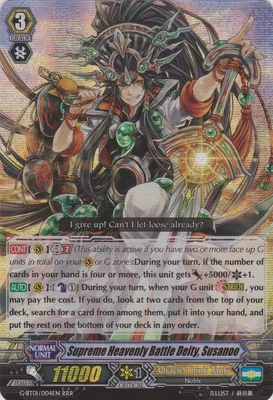
- Trial Deck 1: Handy Helpers, to support Oracle Think Tank
- Trial Deck 2: Now You See Me, to support Ninja
March:
- Booster Set 1: Awakening of the Divine Judgment of the Dragon Lord Elemental Wizard Gods. Supports Oracle Think Tank, Ninja, Suicide, Dimension Police, and Rush.
May:
- Clan Booster 1: Supa Hot Fiah. Supports Control.
July:
- Clan Booster 2: More Fanservice. Supports Bermuda Triangle.
September:
- Booster Set 2: Inevitable Heat Death of the Universe. Supports Angel Feather, Soul, Granblue, and Douchebag.
November:
- Clan Booster 3: Bushi's Money Ho Ho Ho's. Supports Paladin.
That's all 12 clans, in set releases staggered 2 months apart, so power creep is slowed down (compared to the once a month set release we have currently), and this system honestly leaves room for more clans. Or they could scrap their current release format altogether and release 6-10 cards per clan in each set, which guarantees that everyone will be able to get something out of every new set, while allowing Bushi to build up a certain deck idea over the course of a year. As sets are now, decks are pretty much self-contained within their sets. The entirety of the G-era Angel Feather deck was released in set 4. Sure, the deck would welcome more support, but its not like there's some big hole in their deck's strategy that needs another set to patch. The current format Bushi seems to be taking for G-era support is something like this:
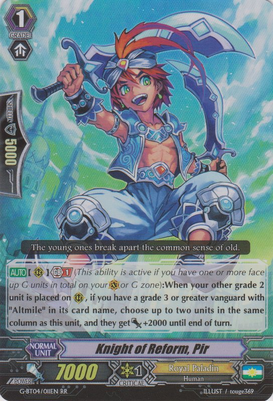
Clan's initial set of support includes:
- On-stride Grade 3 boss unit
- On-hit/Initial stride
- Persona Flipping Finisher Stride
- Amber Clone
- Unflipping Perfect Guard
- Obligatory GB1 RG units.
A Clan that gets a second set of support receives the following:
- Stride version of their G3 on-stride boss
- A critical trigger for their G3 on-stride boss
- A Grade 2 Benizel clone
- A Grade 1 Pir clone
If Bushi kept a formula like this, where they released an on-stride boss and stride units for every clan in the year's first booster, then released a better RG kit for each clan in the following booster, and finally released upgraded versions of the boss units in a 3rd booster, they would have a pretty good formula going. A 4th or even 5th booster could be dedicated to "Legacy" support, which would serve the same purpose as something like Fighter's Collection to give older, mascott cards support (like their own stride forms) to make them viable in the current format.
